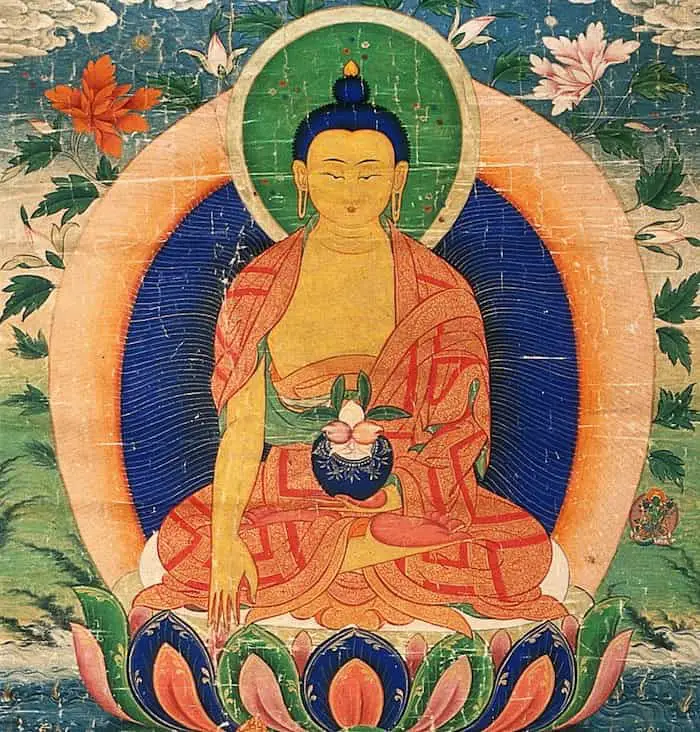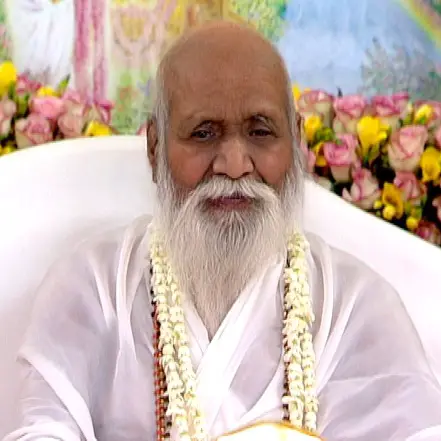The Mantra of Medicine Buddha, also known as the Medicine Buddha Mantra, is a powerful tool for invoking the healing energy of Medicine Buddha.
This ancient mantra has been chanted by Buddhists for centuries, and its efficacy is widely acknowledged.
In this article, we will explore the meaning and significance of the Mantra of Medicine Buddha, its benefits, and how to incorporate it into your daily practice.

Table of Contents
Mantra of Medicine Buddha
Purpose and Benefits of Mantra of Medicine Buddha
The Mantra of Medicine Buddha is a powerful tool for healing and promoting well-being, both on a physical and spiritual level.
Here are some of the main purposes and benefits of the mantra:
- Healing: The Mantra of Medicine Buddha is believed to contain the essence of Medicine Buddha’s healing energy, and chanting the mantra can help alleviate physical, mental, and emotional suffering. It is often used as a complementary practice to support medical treatment and promote the healing process.
- Purification: The mantra is also believed to have the power to purify negative karma and negative emotions, and promote spiritual awakening. By chanting the mantra with sincere intention, one can connect with the transformative power of Medicine Buddha and bring about positive change in one’s life.
- Connection: The mantra is a way to connect with the energy of Medicine Buddha, who is a symbol of the buddhas’ and bodhisattvas’ compassion and wisdom. By chanting the mantra, one can feel a sense of connection with the broader Buddhist tradition and the compassionate energy that permeates the universe.
- Focus: Chanting the mantra can also be a way to cultivate concentration and focus the mind. By repeating the mantra over and over, one can enter into a meditative state and experience a sense of inner peace and calm.
- Generosity: In some Buddhist traditions, chanting the Mantra of Medicine Buddha is also considered a form of generosity. By dedicating the chanting to the well-being of others, one can cultivate a sense of compassion and altruism, and deepen one’s spiritual practice.
Overall, the Mantra of Medicine Buddha is a powerful tool for promoting physical, mental, and spiritual well-being, and can be a valuable addition to anyone’s spiritual practice.
Application and Use of Mantra of Medicine Buddha
The Mantra of Medicine Buddha is commonly used as a tool for invoking the healing energy of Medicine Buddha. It is believed that by chanting the mantra, one can help alleviate physical, mental, and emotional ailments. The mantra can be chanted in a variety of settings, including during meditation, before or after a healing session, or simply throughout the day as a way to connect with the energy of Medicine Buddha.
One way to incorporate the Mantra of Medicine Buddha into your daily practice is to chant it while visualizing Medicine Buddha’s healing light filling your body and mind. You can also dedicate the chanting of the mantra to someone who is in need of healing.
In addition to chanting the mantra, many Buddhists also use images or statues of Medicine Buddha as a focal point for their practice. These images are believed to help connect the practitioner with the energy of Medicine Buddha and aid in the healing process.
It is important to note that while the Mantra of Medicine Buddha can be a powerful tool for healing, it should not be used as a replacement for medical treatment. Rather, it can be used as a complementary practice to support the healing process.
How do I practice Mantra of Medicine Buddha?
Here is a step-by-step guide on how to practice the Mantra of Medicine Buddha:
- Find a quiet and comfortable place to sit where you won’t be disturbed.
- Take a few deep breaths and allow yourself to relax.
- Visualize Medicine Buddha, either through an image or statue, or by simply imagining his presence.
- Focus on your intention for the practice, whether it is to alleviate physical pain, emotional suffering, or simply to connect with the healing energy of Medicine Buddha.
- Begin chanting the Mantra of Medicine Buddha, either out loud or silently. You can use a mala or prayer beads to keep track of your repetitions, or simply chant for a specific amount of time.
- As you chant, visualize Medicine Buddha’s healing light filling your body and mind, and imagine any pain or suffering being transformed into pure, healing energy.
- If you are chanting for someone else, visualize them being surrounded by Medicine Buddha’s healing light and imagine them being free from suffering.
- When you are ready to finish, take a few deep breaths and allow yourself to feel the effects of the practice.
- You can repeat this practice as often as you like, either daily or as needed.
Remember, the Mantra of Medicine Buddha should be practiced with respect and intention, and should not be used as a replacement for medical treatment. If you are experiencing serious physical or mental health issues, it is important to seek the advice of a qualified healthcare professional.
History and meaning for Mantra of Medicine Buddha
The Mantra of Medicine Buddha has its origins in Mahayana Buddhism, and is believed to have been taught by Shakyamuni Buddha himself. According to Buddhist tradition, Medicine Buddha is a bodhisattva who embodies the healing power of all the buddhas, and who is able to alleviate physical, mental, and emotional suffering.
The mantra is believed to contain the essence of Medicine Buddha’s healing energy, and is therefore considered to be a powerful tool for invoking his help. The mantra is often chanted during healing ceremonies or as a daily practice to help alleviate suffering and promote well-being.
The mantra itself is rich in symbolism and meaning. “Bhagavate” is a title that refers to a fully awakened being, such as a buddha or bodhisattva. “Beshaje” means medicine or healing, and “Maha Beshaje” means great medicine or supreme healing. “Raja Samudgate” means king or lord of the Lapis Lazuli Pure Land, which is said to be the pure realm where Medicine Buddha resides. “Swaha” is a Sanskrit word that is often used as an invocation, and can be translated as “may it be so.”
In addition to its healing properties, the Mantra of Medicine Buddha is also believed to have the power to purify negative karma and promote spiritual awakening. By chanting the mantra with sincere intention and devotion, one can connect with the transformative power of Medicine Buddha and bring about positive change in one’s life and in the world.
Overall, the Mantra of Medicine Buddha is a profound expression of the healing and transformative power of the buddhas and bodhisattvas, and is a powerful tool for those seeking to alleviate suffering and cultivate well-being.
Other mantras similar to Mantra of Medicine Buddha
There are many mantras in the Buddhist tradition that are similar in nature to the Mantra of Medicine Buddha, in that they are believed to contain the essence of the buddhas’ and bodhisattvas’ energy and can be used to promote healing and spiritual awakening. Here are a few examples:
- Om Mani Padme Hum: This is perhaps the most well-known mantra in the Buddhist tradition, and is associated with the bodhisattva of compassion, Avalokiteshvara. The mantra is believed to promote compassion, wisdom, and spiritual awakening.
- Om Tare Tuttare Ture Soha: This mantra is associated with Tara, the female bodhisattva of compassion and protection. The mantra is believed to promote protection, healing, and liberation from suffering.
- Namo Amitabha: This mantra is associated with Amitabha Buddha, who presides over the Pure Land of Ultimate Bliss. The mantra is believed to promote rebirth in the Pure Land, where one can cultivate wisdom and compassion and eventually attain enlightenment.
- Om Ah Hum Vajra Guru Padma Siddhi Hum: This mantra is associated with Guru Rinpoche, also known as Padmasambhava, who is considered to be the founder of Tibetan Buddhism. The mantra is believed to promote spiritual awakening, transformation, and the attainment of the rainbow body.
- Om Muni Muni Mahamuni Shakyamuniye Soha: This mantra is associated with Shakyamuni Buddha, the historical Buddha, and is believed to promote spiritual awakening, wisdom, and compassion.
Overall, there are many mantras in the Buddhist tradition that can be used for healing, spiritual awakening, and promoting well-being. It is important to choose a mantra that resonates with your personal practice and intention, and to approach the practice with sincerity and devotion.
Frequently Asked Questions for Mantra of Medicine Buddha
What is the origin of the Mantra of Medicine Buddha?
The Mantra of Medicine Buddha is believed to have originated in India, and was later transmitted to Tibet and other parts of Asia as part of the Buddhist tradition.
How many times should I chant the Mantra of Medicine Buddha?
There is no set number of times to chant the mantra, but it is recommended to chant it at least 108 times as a traditional practice. However, one can also chant the mantra for a shorter or longer period of time, depending on their personal practice and intention.
How long does it take to see the benefits of practicing the Mantra of Medicine Buddha?
The benefits of practicing the mantra may vary depending on the individual and their intention. Some people may experience immediate benefits, such as a sense of calm and peace, while others may experience more long-term benefits, such as improved health and well-being.
It is important to approach the practice with patience and a positive attitude, and to trust in the healing power of Medicine Buddha.
Can anyone practice the Mantra of Medicine Buddha?
Yes, the mantra can be practiced by anyone, regardless of their spiritual background or religious affiliation. It is important to approach the practice with sincerity and devotion, and to cultivate a positive intention to promote healing and well-being.
See Related Posts

Mantras to Live By

Best Mantras for Exams

Transcendental Meditation Mantras

